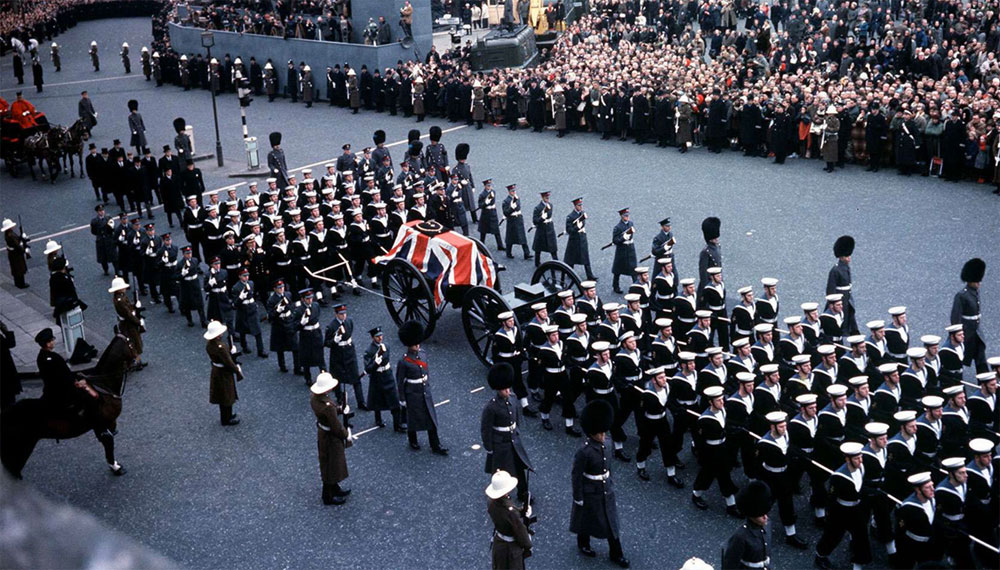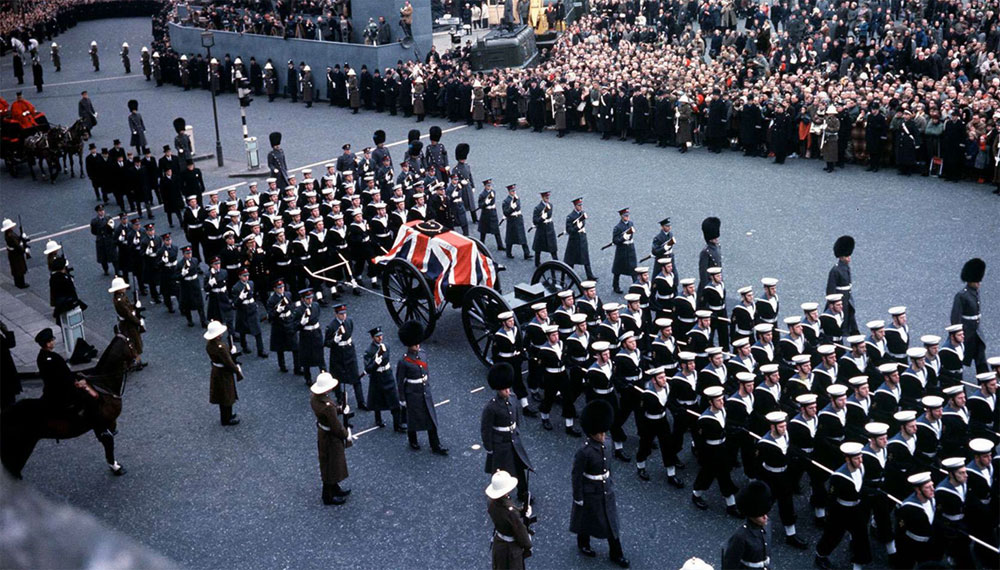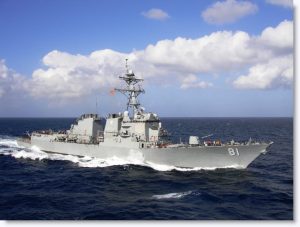
In Memoriam
Grieving in London Town

Winston Churchill's funeral cortege makes its way down Whitehall in London. In London, a million people reportedly gathered along the route to watch the procession pass by on the morning of the state funeral, 30 January 1965
December 17, 2006
Articles from the day:
The funeral procession, the church service, the final salute:
From Westminster to St. Paul’s
Greatest Englishman is Borne
Through Grieving London Town
Big Ben Silent, Ten Bands Play
Mourners Breakfast at Curbside
by John MacSween
LONDON (CP) The body of Sir Winston Churchill was borne through grieving London on his state funeral today in a spectacle of heart-gripping homage.

2024 International Churchill Conference
Big Ben tolled the last time for the greatest Englishman by signalling the start of his majestic funeral procession from Westminster at 9:45 a.m. on a cold clear day.
Then the famed clock, indelibly associated with Britain’s valor in wartime days, was silenced until midnight in honor of Churchill, who had lain in state for three days in Westminster Hall, a few hundred yards away.
Thousands lined the route of the funeral procession, many of them having spent the night on the cold curbings and sidewalks.
Women clamored for newspapers — not to read but to protect their legs against the cold.
Near the statue of the Duke of Wellington in the heart of London, one group fried eggs and bacon on a portable stove.
Outside St. Paul’s Cathedral, scene of the funeral service, thousands packed the sidewalks. Hundreds hung in the windows of the nearby buildings.
Westminster Hall, where Churchill, who died last Sunday of a stroke, had lain in state since Wednesday, was closed at 6 a.m. Hundreds still waiting to file through the hall, past the catafalque, had to be turned away.
The last to take leave of Churchill’s coffin at the lying in state was Robert Ward, a 60-year-old driver for Westminster hospital. For the last three days he had driven nurses to and from the hall to watch over the queues.
In keeping with Churchill’s wishes, the burial this afternoon at Bladon was to be in a quiet country churchyard, closed to all but immediate members of his family.
The thousands along the processional route from Westminster to St. Paul’s huddled under blankets, in sleeping bags and wrapped plastic sheets around themselves to ward off the chill wind.
Magnificence and Pathos
110 Nations mourn at St. Paul’s
by Norman Phillips, The Toronto Star staff writer
LONDON In the magnificent service at St. Paul’s — a service never before attempted and impossible of repetition –Winston Churchill’s name was not once mentioned.
The unspoken praise came from the multitude representing 110 nations.
From my seat in the cathedral nave I watched the two-hour ceremony as the Archbishop of Canterbury and the Earl Marshal assembled a great cast of international figures for the state funeral.
As I entered the cathedral at 9 a.m. an almost blind light bathed the scrubbed stone walls of the ancient building.
Ushers with gold-tipped purple batons directed the early members of the congregation to their seats.
Mute television monitors hung from the wall recording events outside and two miles away where the funeral procession was assembling.
Directly beneath the 365-feet-high dome stood the waiting catafalque, its dull black velvet cross-hatched with silver.
6 candles, 3 gilt chairs
Beside it stood six black candlesticks with dull-gold beeswax candles and in front of it three red upholstered gilt chairs for the Queen, the Queen Mother and Prince Philip.
A workman in open-necked shirt mounted a 12-foot ladder to light the tapers, and a powerful vacuum cleaner sounded throughout the building as it removed footprints from the bright blue carpeting.
In the midst of these last-minute preparations, Lord Moran, Churchill’s family doctor, walked down the aisle behind Apostolic Delegates in magenta robes. African diplomats in brightly-colored togas and bewigged legal officers.
It was like the stage setting for an extravaganza as characters were added one by one while the coffin rolled on inexorably from Westminster Hall.
By 10 minutes to 10 the scarlet-clad aldermen and high officers of the City of London filed through the south door and took their seats in the choir stalls.
Speaker follows mace
The speaker of the House of Commons in gilt-embroidered black robes followed the mace bearer to his place under the dome and one minute later the Lord Chancellor preceeded by his mace took his seat along side the speaker.
Attendants waited with dark velvet cloths with which the maces must be covered in the presence of the Queen.
Gold-emblazoned officers of chivalry with lacy black mourning sashes over their scabards entered bearing Sir Winston’s sword, crest and spurs, while the Lord Chamberlain went out of the cathedral to greet heads of state and royal representatives at the foot of the steps.
Among these President Charles de Gaulle and Russia’s Marshal Ivan Konev, both in magnificent military uniforms, dominated the groups with whomthey entered.
The lord mayor of London was the last to arrive before the Queen. Carrying a four-foot, two-inch black mourning sword, he stood at the cathedral entrance greeting the royal party and leading them to where the Archbishop stood in the vestibule.
As the seldom-opened huge west doors swung on creaking hinges, the throb of the drums from the great procession mingled with the gentle organ music within the cathedral.
Finally, on the television screens, the gun carriage could be seen drawn up in the forecourt of St. Paul’s and the bare-headed guardsmen stood the burden of the coffin on their shoulders.
At a signal from the earl marshal the procession entered the great west door at 10:49 and paced slowly up the nave followed by the pallbearers, officers bearing the Churchill banners, his orders and decoration, and his achievements, and place them on a black velvet covered table to the east of the catafalque. Then, the traditional Church of England service began with the choir chanting “the sentences” beginning “I am the resurrection and the life.”
When the coffin was placed upon the bier, the whole congregation sang “Who Would True Valor See, Let Him Come Hither.”
The 30-minute service ended with the Archbishop of Canterbury standing on the altar steps facing the congregation with his cross of office in his hand and offering a benediction.
Trumpeter high in dome
Then came the national anthem, and as it ended a trumpeter, high in the galleries of the dome, sounded the Last Post. As the last notes died away a bugler silhouetted against the narrow windows over the west door replied with reveille and the service was ended.
The bearer party, their faces bathed with perspiration from their heavy burden, led the procession out of the cathedral followed by the heavily-veiled Lady Churchill accompanied by her only son, Randolph.
In the cathedral forecourt, the family party mounted the five state carriages for the next stage of the procession, to Tower Hill and the waiting launches on the Thames.
Led by the lord mayor, the Queen walked to the great west door where the dean and chapter, the Bishop of London and the Archbishop of Canterbury took formal leave of her. She then watched the great procession move off to the beat of the shrouded drums.
Royal Artillery men fired a 19-gun salute as the procession gathered momentum and at Tower Hill 60 massed pipers began the lament as the state funeral proper ended with the transfer of the body to the river launch Havengore for the voyage upriver.
Out of the pale noon clouds, there suddenly streaked 16 Lightning fighters of the Royal Air Force in a final service tribute.
19 Guns Boom Farewell
by Joseph MacSween
LONDON (CP) Sir Winston Churchill received awesome final tribute in a state funeral today and then, beneath saluting jet fighter planes, his body was borne along the Thames enroute to his last resting place in the heart of England.
Guns boomed out a 19-gun salute — the first time a commoner has received any more than 17 guns — as the remains of the warrior-statesman were placed aboard a launch for his last short voyage on the Thames, river highway of history.
The homage by queens, kings, presidents and prime ministers was over. So was the martial splendor and solemnity, the pageantry and pomp, dying awayin the strains of a lament by kilted pipers.
Britain and the world, in effect, thus returned Sir Winston to the hands of his loved ones for burial at Bladon, Oxfordshire, beside his parents in a village churchyard near Blenheim Palace, his birthplace.
From Westminster to St. Paul’s
to Tower of London Pier
and on to Waterloo and train to Bladon.
The body of Sir Winston, who frequently made trips in battleships and other large vessels of the fleet, was then taken to the Tower of London Pier and placed aboard the launch Havengore for the short voyage across the Thames to Festival Pier, and thence to Waterloo.
Churchill, as a young soldier, left home to join a cavalry regiment. Today men of the regiment, the Queen’s Roal Irish Hussars, carried his coffin to the train for what was called “the long mile home.”
1,000,000 line route
An epic circle had been completed.
The cream-and-black train, drawn by the old steam locomotive named Winston Churchill, left Waterloo station and passed through such towns as Twechenham and Virginia Water on the 72-mile trip to Bladon.
The peaceful Oxfordshire scene contrasted with the state funeral in which more than 1,000,000 persons — by police estimates — lined the route of the procession from Westminster to St. Paul’s Cathedral for the service attended by the Queen and many world leaders.
Subscribe
WANT MORE?
Get the Churchill Bulletin delivered to your inbox once a month.



